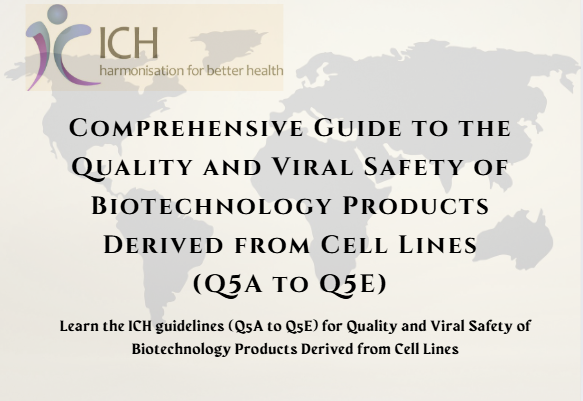Learn the ICH guidelines (Q5A to Q5E) for Quality and Viral Safety of Biotechnology Products Derived from Cell Lines
Comprehensive Guide to the Quality and Viral Safety of Biotechnology Products Derived from Cell Lines (Q5A to Q5E)
Comprehensive Guide to the Quality and Viral Safety of Biotechnology Products Derived from Cell Lines (Q5A to Q5E)
Biotechnology products derived from cell lines of human or animal origin play a vital role in modern medicine. These products, which include monoclonal antibodies, recombinant vaccines, and therapeutic proteins, must undergo rigorous safety evaluations to ensure they are free from viral contamination and meet the highest standards of quality. The International Council for Harmonisation (ICH) guidelines—Q5A to Q5E—offer essential frameworks for ensuring the safety, stability, and consistency of these complex biologics.
Viral Safety Evaluation (Q5A(R1))
Viral Safety Evaluation (Q5A(R1))
The Q5A(R1) guideline focuses on the viral safety of biotechnology products derived from characterized cell lines, including mammalian, avian, and insect sources. The primary concern is to prevent contamination from infectious viruses, whether introduced adventitiously or present in the original cell substrate.
Key Strategies for Viral Safety:
- Selection and Testing of Cell Lines: All raw materials, especially the cell lines and culture media, must be screened for infectious or pathogenic viruses.
- Assessment of Viral Clearance: Production processes should be validated for their capacity to remove or inactivate viruses.
- In-Process and Final Product Testing: Critical stages in the manufacturing process must be monitored to ensure the absence of viral contaminants.
Limitations and Considerations:
Due to the statistical limits of virus detection methods, a multi-layered approach is essential. No single test can guarantee safety; instead, confidence comes from a comprehensive strategy combining virus testing and robust manufacturing controls.
Products like inactivated vaccines and genetically engineered live vectors are excluded from this guideline. However, the framework is particularly relevant for products developed using recombinant DNA (rDNA) technologies, such as interferons, monoclonal antibodies, and subunit vaccines.
Quality of Biotechnological Products (Q5B)
Quality of Biotechnological Products (Q5B)
The Q5B guideline provides standards for the characterization of expression constructs used to produce rDNA-derived protein products. Whether using eukaryotic or prokaryotic cells, it’s vital to analyze the expression vector, which contains the gene encoding the therapeutic protein.
Key Focus Areas:
- Nucleic Acid Analysis: Essential for verifying the structure of the coding sequence.
- Protein-Level Characterization: Includes assessing folding, post-translational modifications, and structural integrity.
This ensures the final recombinant protein is consistent and meets safety expectations throughout production batches.
Stability Testing of Biotech Products (Q5C)
Stability Testing of Biotech Products (Q5C)
The Q5C guideline addresses the stability testing of well-characterized biotech/biological products. Stability studies are critical for determining a product’s shelf-life and storage conditions.
Products Covered Include:
- Cytokines (e.g., interferons, interleukins)
- Monoclonal antibodies
- Growth hormones and factors
- Recombinant insulin
- Erythropoietins and other plasma-derived proteins
These studies evaluate physical, chemical, biological, and microbiological attributes over time to ensure product efficacy and safety throughout its life cycle.
Cell Substrate Characterization (Q5D)
Cell Substrate Characterization (Q5D)
The Q5D guideline outlines best practices for the derivation and characterization of cell substrates, the living cells used to produce biologics. These substrates may include microbial cells or human/animal-derived cell lines, such as continuous or diploid lines.
Key Aspects of Cell Substrate Documentation:
- History and Origin of Cells
- Cell Banking and Storage Systems
- Manipulation Records
- Characterization of Genetic Stability and Identity
Even if documentation is incomplete, thorough testing and characterization of the cell line can support approval, provided other robust controls are in place.
Comparability After Manufacturing Changes (Q5E)
Comparability After Manufacturing Changes (Q5E)
Biotech manufacturers often need to make changes to their production processes. The Q5E guideline provides a framework for demonstrating comparability before and after such changes.
Comparability Evaluation Includes:
- Structural and functional analysis of the product
- Assessment of any potential impact on safety, efficacy, and quality
- Use of analytical, nonclinical, and clinical data as needed
The goal is to provide scientific justification that any modifications to the process do not compromise the product’s therapeutic value or increase safety risks.
Conclusion
Biotechnological products derived from human or animal cell lines require rigorous oversight to ensure their quality, stability, and viral safety. The ICH Q5A to Q5E guidelines provide a structured approach for manufacturers to design, evaluate, and validate their production and testing protocols. By adhering to these standards, developers not only safeguard public health but also streamline the regulatory approval process.
Whether you’re involved in regulatory affairs, quality control, or biopharmaceutical manufacturing, understanding and implementing these guidelines is crucial for delivering safe, effective, and high-quality biologics.

